Improve Relationship Communication: 7 Powerful Ways
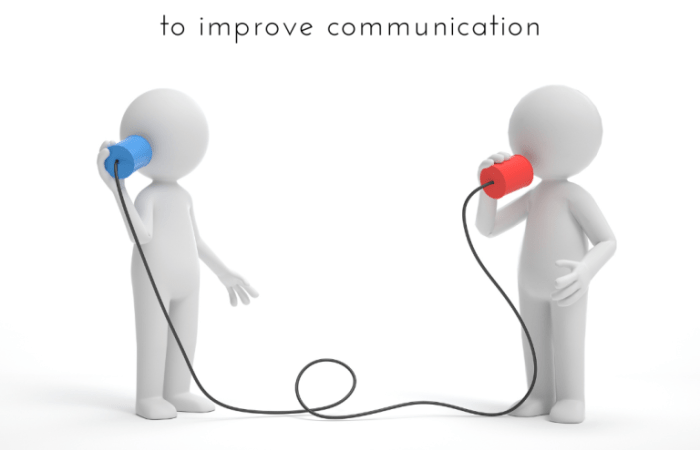
Strong communication is the cornerstone of any healthy relationship. Whether you’re navigating the complexities of a romantic partnership, familial bonds, or professional connections, the ability to express yourself clearly and listen attentively is crucial. ‘Ways to Improve Communication in a Relationship’ delves into practical strategies and insights that can enhance your communication skills and foster deeper connections.
This guide explores a comprehensive framework for improving communication, encompassing active listening, clear and direct expression, conflict resolution, emotional intelligence, non-verbal cues, setting boundaries, and seeking professional help when needed. Each section offers actionable tips and techniques to help you build a more fulfilling and harmonious relationship.
Active Listening and Understanding
Active listening is a fundamental skill for building strong and healthy relationships. It goes beyond simply hearing what your partner is saying; it involves truly understanding their perspective, emotions, and intentions. By actively listening, you demonstrate respect, empathy, and a genuine interest in your partner’s thoughts and feelings.
Benefits of Active Listening
Active listening is essential for effective communication in relationships. It helps foster deeper understanding, strengthens emotional connections, and promotes a sense of validation and support. By actively listening, you can:
- Resolve conflicts more effectively: When both partners actively listen to each other’s perspectives, it becomes easier to identify the root causes of disagreements and find mutually acceptable solutions.
- Build trust and intimacy: When you show your partner that you are truly listening and understanding them, it fosters a sense of trust and intimacy. It allows you to connect on a deeper level and feel more emotionally connected.
- Improve communication overall: Active listening creates a safe and supportive environment for open and honest communication. It encourages both partners to express their thoughts and feelings without fear of judgment or dismissal.
Practical Tips for Active Listening
Here are some practical tips for demonstrating active listening:
- Paraphrase what your partner says: Repeating what you heard in your own words shows that you are paying attention and understanding their message. This also provides an opportunity to clarify any misunderstandings.
- Ask clarifying questions: If you are unsure about something your partner said, don’t hesitate to ask for clarification. This shows that you are genuinely interested in understanding their perspective.
- Avoid interrupting: Let your partner finish their thoughts without interrupting. Jumping in with your own opinions or experiences can make them feel unheard and disrespected.
- Maintain eye contact: Eye contact demonstrates that you are engaged and paying attention. It also helps you to better understand your partner’s nonverbal cues.
- Use nonverbal cues: Nodding your head, leaning in, and maintaining a relaxed posture show that you are listening attentively. Avoid distractions like looking at your phone or checking your watch.
- Focus on understanding, not just responding: When you are actively listening, your goal is to understand your partner’s perspective, not to formulate your response. Resist the urge to interrupt or jump in with your thoughts until they have finished speaking.
Examples of Active Listening in Relationship Scenarios
Here are some examples of how active listening can improve communication in various relationship scenarios:
- During a disagreement: Instead of immediately defending your position, actively listen to your partner’s perspective. Try to understand their feelings and the reasons behind their point of view. This can help you find common ground and reach a mutually acceptable solution.
- When sharing important news: When your partner shares exciting news or difficult news, actively listen to their emotions and reactions. Offer your support and understanding without interrupting or dismissing their feelings.
- During everyday conversations: Even in casual conversations, active listening can strengthen your bond. Show genuine interest in your partner’s day, their thoughts, and their feelings. This helps you to build a deeper connection and create a sense of intimacy.
Clear and Direct Communication: Ways To Improve Communication In A Relationship
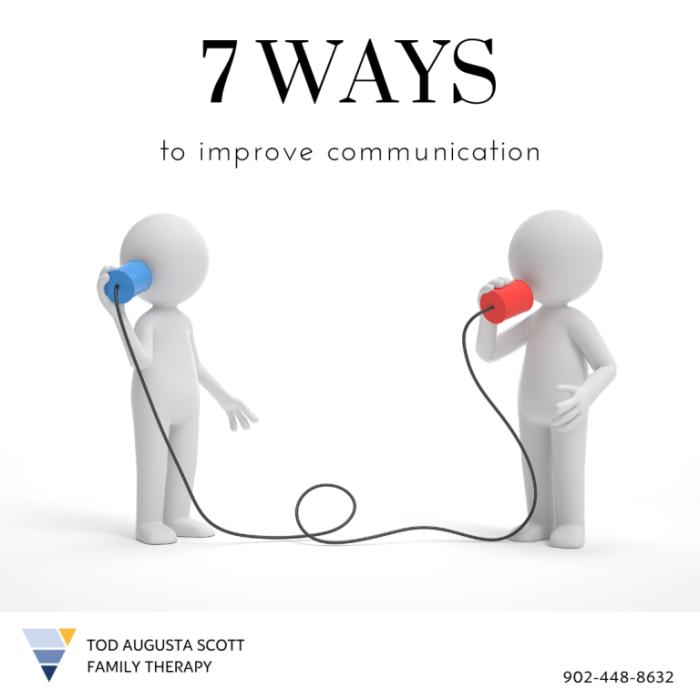
Clear and direct communication is the cornerstone of any healthy relationship. It fosters trust, understanding, and a sense of emotional security. When partners can openly and honestly express their thoughts and feelings, it creates a foundation for resolving conflicts, building intimacy, and navigating life’s challenges together.
Benefits of Clear and Direct Communication
Clear and direct communication benefits relationships in various ways. It fosters trust, understanding, and emotional security. When partners can openly and honestly express their thoughts and feelings, it creates a foundation for resolving conflicts, building intimacy, and navigating life’s challenges together.
Using “I” Statements
Using “I” statements is a powerful technique for expressing personal feelings and needs without blaming or attacking the other person. When you use “I” statements, you take ownership of your emotions and experiences, making it easier for your partner to understand your perspective.
“I feel hurt when you don’t call me back.”
This statement communicates the speaker’s feelings without accusing the listener. It also allows the listener to understand the impact of their actions on the speaker.
Assertive Communication Techniques
Assertive communication is a vital skill for expressing your needs and boundaries respectfully. It involves being direct, honest, and clear about your feelings and expectations. Here are some assertive communication techniques and their benefits:| Technique | Benefits ||—|—|| Using “I” Statements| Expresses personal feelings and needs without blaming or attacking.
|| Active Listening| Shows genuine interest in the other person’s perspective. || Setting Boundaries| Protects your needs and limits unhealthy behaviors. || Using “I” Statements| Expresses personal feelings and needs without blaming or attacking. || Asking for What You Need| communicates your expectations and desires.
|| Negotiating and Compromising| Finds solutions that work for both parties. |
Conflict Resolution Strategies
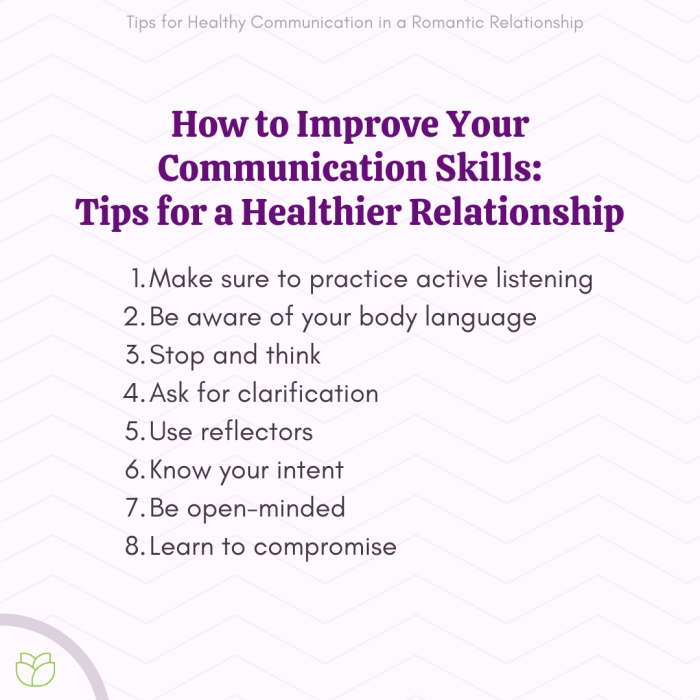
Healthy communication is crucial for any relationship, but it is especially important when navigating disagreements. Conflict is an inevitable part of any close connection, but how you approach and resolve it can make a significant difference in the overall health and longevity of your relationship.
Conflict Resolution Strategies
Different approaches can be used to resolve conflicts, each with its strengths and weaknesses. Some common strategies include compromise, negotiation, and mediation.
- Compromise involves finding a solution that partially satisfies both parties’ needs. This requires a willingness to give up something to reach a mutually acceptable outcome. For example, if one partner wants to go out and the other wants to stay in, they could compromise by agreeing to have a quiet dinner at home followed by a movie night.
- Negotiation is a more formal process where both parties actively discuss their needs and interests to reach an agreement. It involves active listening, clear communication, and a willingness to be flexible. For instance, if a couple is arguing about finances, they might negotiate a budget that addresses both their financial goals and spending habits.
- Mediation involves a neutral third party facilitating communication between the disputing parties. The mediator helps them understand each other’s perspectives, identify common ground, and develop a mutually acceptable solution. Mediation can be particularly helpful in complex conflicts where emotions are running high and direct communication is difficult.
Effectiveness of Conflict Resolution Strategies
The effectiveness of each strategy depends on the specific situation and the individuals involved.
- Compromise can be effective in resolving minor disagreements or when both parties are willing to make concessions. However, it may not be suitable for situations where one person’s needs are significantly more important than the other’s.
- Negotiation is often a more successful approach for resolving complex issues, as it allows for a more in-depth exploration of needs and interests. However, it requires a high level of communication skills and a willingness to be flexible.
- Mediation can be highly effective in situations where direct communication is difficult or when emotions are running high. However, it requires the parties to be willing to participate and engage with the mediator.
Constructive Conflict Resolution Process
A constructive conflict resolution process aims to address the issue effectively while maintaining a healthy relationship.
A constructive conflict resolution process involves the following steps:
- Identify the Issue: Clearly define the source of the conflict and what each person’s needs and concerns are.
- Active Listening: Pay attention to your partner’s perspective, trying to understand their feelings and needs without interrupting or becoming defensive.
- Communicate Respectfully: Express your own needs and feelings clearly and respectfully, using “I” statements to avoid blaming or accusing your partner.
- Brainstorm Solutions: Together, generate a list of potential solutions that address both parties’ needs.
- Choose a Solution: Evaluate the proposed solutions and choose one that is mutually acceptable and feasible.
- Implement and Evaluate: Put the chosen solution into practice and monitor its effectiveness. Be willing to adjust the solution if necessary.
Emotional Intelligence and Empathy
Emotional intelligence (EQ) plays a crucial role in effective communication, particularly in relationships. It enables individuals to understand and manage their own emotions while also recognizing and responding to the emotions of others. By developing EQ skills, couples can build stronger connections, resolve conflicts constructively, and foster a more fulfilling and harmonious relationship.
The Impact of Emotional Intelligence on Communication
Developing emotional intelligence is essential for effective communication in relationships. It allows partners to understand and manage their own emotions while also recognizing and responding to the emotions of others. This fosters empathy, understanding, and connection.
- Self-awareness: Understanding one’s own emotions, triggers, and how they affect communication. Individuals with high self-awareness can identify their emotional state and express their needs and feelings clearly. For example, if someone is feeling overwhelmed, they can acknowledge this feeling and communicate it to their partner instead of reacting defensively or withdrawing.
- Self-regulation: The ability to manage emotions effectively, preventing impulsive reactions and choosing appropriate responses. By regulating emotions, partners can avoid escalating conflicts and communicate calmly and constructively. For instance, if someone feels frustrated, they can take a moment to calm down before responding, rather than reacting angrily.
- Empathy: The capacity to understand and share the feelings of others. Empathetic individuals can listen attentively, acknowledge their partner’s perspective, and respond with compassion. This helps create a safe and supportive environment for open and honest communication.
- Social Skills: Effective communication and interaction with others. Individuals with strong social skills can express themselves clearly, actively listen, and build rapport with their partners. This facilitates understanding, reduces misunderstandings, and strengthens the bond between partners.
- Motivation: The drive to achieve personal goals and contribute to the relationship’s well-being. Motivated partners are more likely to engage in meaningful conversations, work together to solve problems, and maintain a positive and supportive atmosphere.
Empathy as a Bridge to Understanding
Empathy is a cornerstone of emotional intelligence and a powerful tool for enhancing understanding and connection in relationships. It involves stepping into the shoes of your partner, seeing the world from their perspective, and recognizing their feelings.
- Active Listening: Paying undivided attention to your partner’s words and nonverbal cues. It involves listening not only to what they say but also to how they say it and trying to understand their underlying emotions and intentions.
- Validating Feelings: Acknowledging and accepting your partner’s emotions, even if you don’t agree with them. This shows respect and understanding, creating a safe space for open communication. For example, instead of saying “You’re being overly sensitive,” you could say “I understand you’re feeling hurt, and I want to hear what happened.”
- Perspective-Taking: Trying to see the situation from your partner’s point of view, considering their thoughts, feelings, and experiences. This helps you understand their motivations and actions, even if you don’t agree with them. For example, if your partner is upset about something, try to understand why they are feeling that way, rather than immediately jumping to conclusions.
Emotional Intelligence Skills and Their Impact on Communication
| Emotional Intelligence Skill | Impact on Communication |
|---|---|
| Self-awareness | Improved clarity in expressing needs and feelings. |
| Self-regulation | Reduced impulsive reactions and constructive conflict resolution. |
| Empathy | Enhanced understanding, compassion, and connection. |
| Social Skills | Effective communication, active listening, and rapport building. |
| Motivation | Engagement in meaningful conversations and problem-solving. |
Non-Verbal Communication
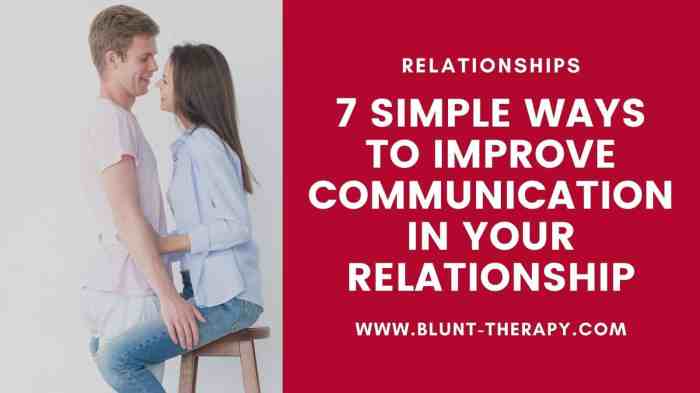
Non-verbal communication plays a crucial role in relationships, often conveying more than words alone. It encompasses a wide range of cues, including body language, tone of voice, and facial expressions, which can either reinforce or contradict verbal messages. Understanding these cues can significantly enhance communication and strengthen relationships.
The Significance of Non-Verbal Cues
Non-verbal cues are powerful tools for communication, providing insights into emotions, intentions, and attitudes that may not be explicitly expressed verbally. They can be subtle or overt, conscious or unconscious, and can influence how messages are received and interpreted.
- Body Language: Posture, gestures, and physical proximity can convey a wide range of emotions and intentions. For example, crossed arms might indicate defensiveness, while leaning in during a conversation can suggest interest and engagement.
- Tone of Voice: The pitch, volume, and rhythm of speech can influence the meaning of words. A gentle tone can convey warmth and understanding, while a sharp tone might indicate anger or frustration.
- Facial Expressions: Facial expressions are a primary way of communicating emotions. A smile can convey happiness, while a frown can express sadness or disapproval.
Examples of Non-Verbal Communication Complementing or Contradicting Verbal Messages
Non-verbal cues can complement or contradict verbal messages, creating a complex interplay of communication. Here are some examples:
- Complementing Verbal Messages: A person saying “I’m fine” while smiling and making eye contact might be genuinely expressing their well-being.
- Contradicting Verbal Messages: A person saying “I’m not angry” while clenching their fists and raising their voice might be masking their true feelings.
Visual Illustration of Non-Verbal Cues Impacting Communication
Imagine two individuals having a conversation. The first individual, agreeing, sits upright, leans forward, maintains eye contact, and nods their head. This combination of non-verbal cues conveys a sense of attentiveness and understanding. In contrast, the second individual sits back, avoids eye contact, and crosses their arms.
This non-verbal behavior might indicate disinterest, boredom, or even disagreement, regardless of the verbal message being communicated.
Setting Boundaries and Expectations
Setting boundaries and expectations is crucial for fostering a healthy and fulfilling relationship. It’s about defining what is acceptable and unacceptable in your relationship, ensuring mutual respect and understanding.
Benefits of Setting Boundaries, Ways to improve communication in a relationship
Clearly defining boundaries helps promote healthy communication and mutual respect. When both partners understand and respect each other’s limits, it fosters a sense of trust and security.
| Type of Boundary | Benefits |
|---|---|
| Physical Boundaries | Respecting each other’s personal space, physical touch, and intimacy. |
| Emotional Boundaries | Protecting your feelings and emotional well-being, preventing emotional dependence or manipulation. |
| Time Boundaries | Balancing personal time, work, and relationship commitments, preventing over-dependence and resentment. |
| Financial Boundaries | Establishing clear financial expectations, managing shared expenses, and avoiding financial conflict. |
| Social Boundaries | Respecting each other’s social circles, friends, and family, ensuring a balance between individual and shared activities. |
Seeking Professional Help
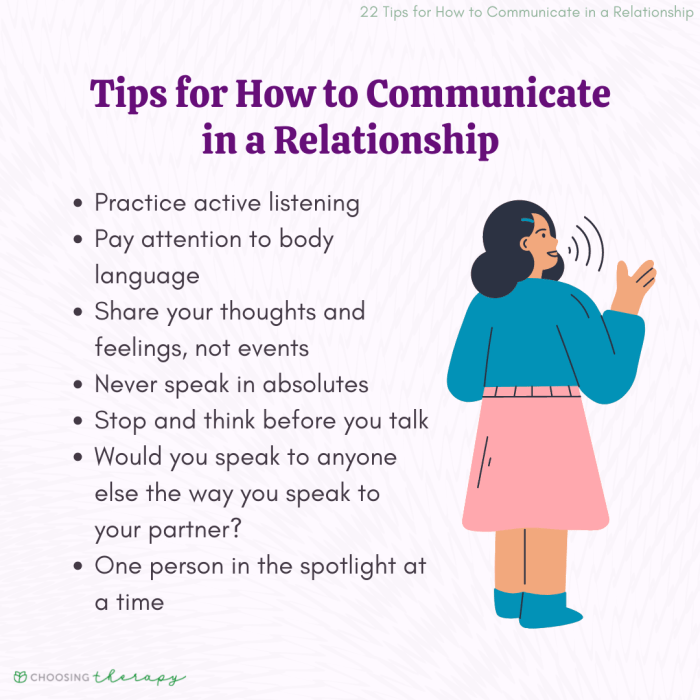
Sometimes, despite our best efforts, communication challenges in a relationship can feel overwhelming and difficult to resolve on our own. This is when seeking professional help from a therapist or counselor can be incredibly beneficial.
Benefits of Couples Counseling
Couples counseling, also known as marriage counseling, provides a safe and structured space for couples to address communication issues, improve their understanding of each other, and develop healthier patterns of interaction. Here are some potential benefits:
- Improved Communication Skills: A therapist can help couples identify communication patterns that are causing conflict and teach them new, more effective ways to express their thoughts and feelings. This can include active listening techniques, non-verbal communication strategies, and conflict resolution skills.
- Increased Understanding: Couples counseling can provide a deeper understanding of each other’s perspectives, needs, and values. By gaining insights into their partner’s motivations and emotional responses, couples can build empathy and strengthen their connection.
- Conflict Resolution Strategies: Therapists can guide couples in developing effective conflict resolution strategies, such as compromise, negotiation, and assertive communication. This can help couples navigate disagreements constructively and prevent conflicts from escalating.
- Enhanced Emotional Intelligence: Couples counseling can help individuals develop their emotional intelligence by increasing self-awareness, understanding their own emotions, and learning how to regulate their emotional responses. This can lead to more balanced and healthy interactions within the relationship.
- Strengthened Relationship Bonds: By addressing communication challenges and improving their understanding of each other, couples can strengthen their bond, improve intimacy, and create a more fulfilling relationship.
Examples of Professional Guidance
- Identifying Communication Patterns: A couple might be struggling with constant arguments about finances. A therapist could help them identify patterns in their communication, such as blaming, defensiveness, or avoidance, and guide them toward more constructive conversations about money.
- Developing Active Listening Skills: A couple might be frustrated with feeling unheard by their partner. A therapist could teach them active listening techniques, such as paraphrasing, reflecting feelings, and asking clarifying questions, to ensure they are truly understanding each other’s perspectives.
- Resolving Conflict: A couple might be stuck in a cycle of arguing about household chores. A therapist could help them develop a shared understanding of their expectations, establish clear communication about responsibilities, and implement a system for constructively resolving disagreements about chores.
End of Discussion

Ultimately, improving communication in a relationship is an ongoing journey. It requires commitment, empathy, and a willingness to learn and grow together. By embracing the principles articulated in this guide, you can cultivate a deeper understanding, strengthen your bonds, and create a more fulfilling and enriching experience for everyone involved.
Comments are closed.